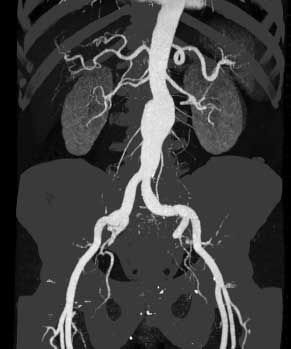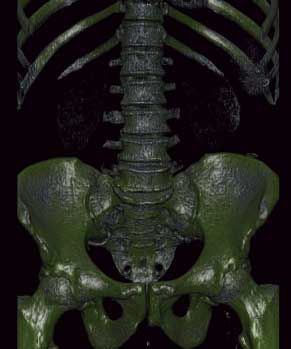Abdominal CTA With Direct Dual Energy Bone Subtraction
A 75-year-old man was referred for presurgical MDCT evaluation of a known abdominal aortic aneurysm that had been detected on screening abdominal ultrasound. A contrast enhanced CTA scan of the abdomen was performed.
HISTORY
A 75-year-old man was referred for presurgical MDCT evaluation of a known abdominal aortic aneurysm that had been detected on screening abdominal ultrasound. A contrast enhanced CTA scan of the abdomen was performed.
DIAGNOSIS
The acquisition parameters allowed precise localization of the origin of the aneurysm with respect to the renal arteries and allowed for necessary measurements of the neck of the aneurysm, the distance from the renal arteries to the aortic bifurcation and to each common iliac bifurcation to be calculated, and the adequacy of the run-off to the lower extremities to be assessed. Finally, a small accessory renal artery supplying the upper pole of the right kidney was detected. Based on this single study, the patient was considered a candidate for endovascular repair.
COMMENTS
The scanning protocol (outlined below) acquired two spiral data sets in a single acquisition; each data set contains unique spectral information, which allows differentiation and characterization of imaged structures and tissue (Fig.1). In this dual energy application, the direct subtraction of bone can be achieved almost instantly with a high degree of accuracy as compared with conventional bone removal techniques. Additionally, critical small vessels such as an accessory right upper pole renal artery can be easily preserved. Using dual energy acquisitions, abdominal CTA segmentations can be performed, eliminating manual post processing steps and thereby significantly reducing reporting time. The degree of bone segmentation is at the discretion of the radiologist; in this example, the dual display allows the vascular map to be superimposed over the skeletal structures. This aids the surgeon in establishing landmarks that can aid in the fluoroscopic based endovascular repair. The success of the bone removal is illustrated in the MIP image (Fig. 2).
Scanner SOMATOM Definition
Scan area Abdominal CT Angiography
Scan length 410 mm
Scan time 12 sec
Scan direction Caudo-cranial
kV 140 kV and 80 kV
Effective mAs 66 eff. mAs and 190 eff. mAs
Rotation time 0.5 sec
Slice collimation 0.6 mm
Spatial resolution 0.33 mm
Slice width 2 mm
Reconstructed slice thickness 2 mm
Increment 1.5 mm
CTDIvol 10.7 mGy
Kernel D20f
Contrast material volume 100 ml
Flow rate 4 ml/s
Bolus tracking On

(Fig. 1) Precise visualization of the abdominal aneurysm and their relations to skeletal landmarks is possible with the SOMATOM Definition.

(Fig. 2) Dual Energy MIP of the abdominal vasculature allows immediate rule out of aneurysms, stenosis or embolism. Notice the lack of interference from bones.

(Fig. 3) Dual Energy VRT, excellent visualization of the abdominal skeleton.